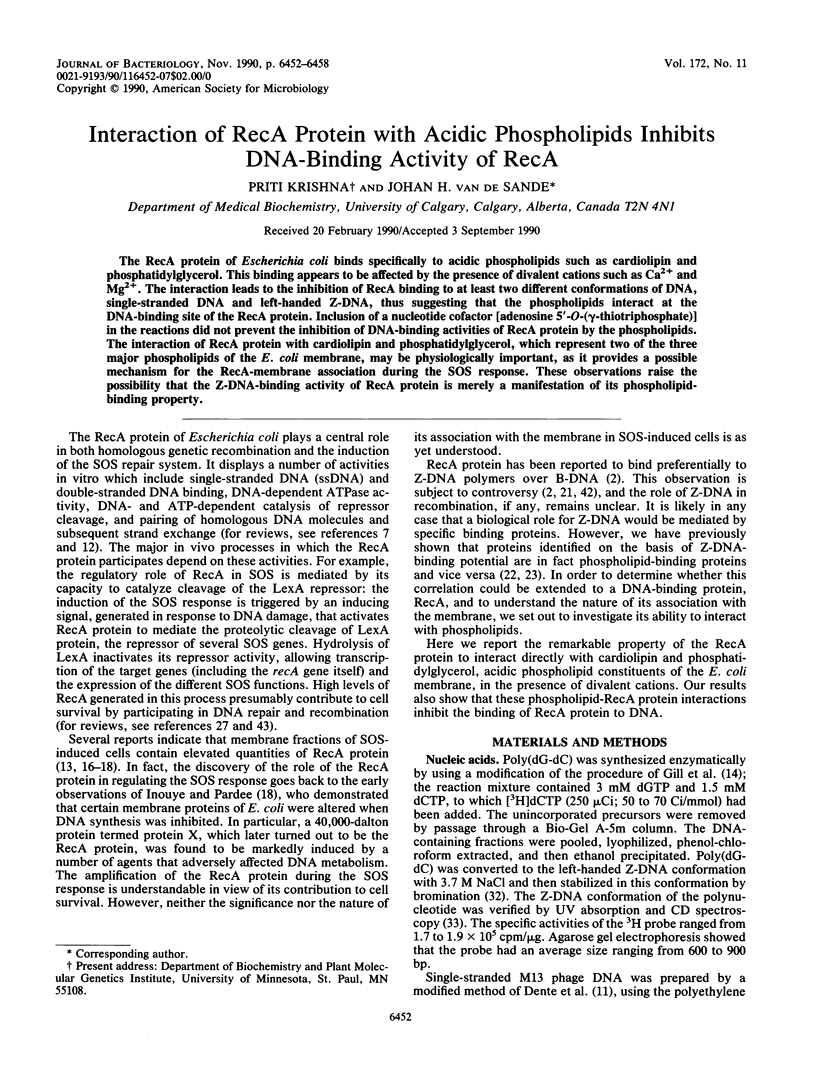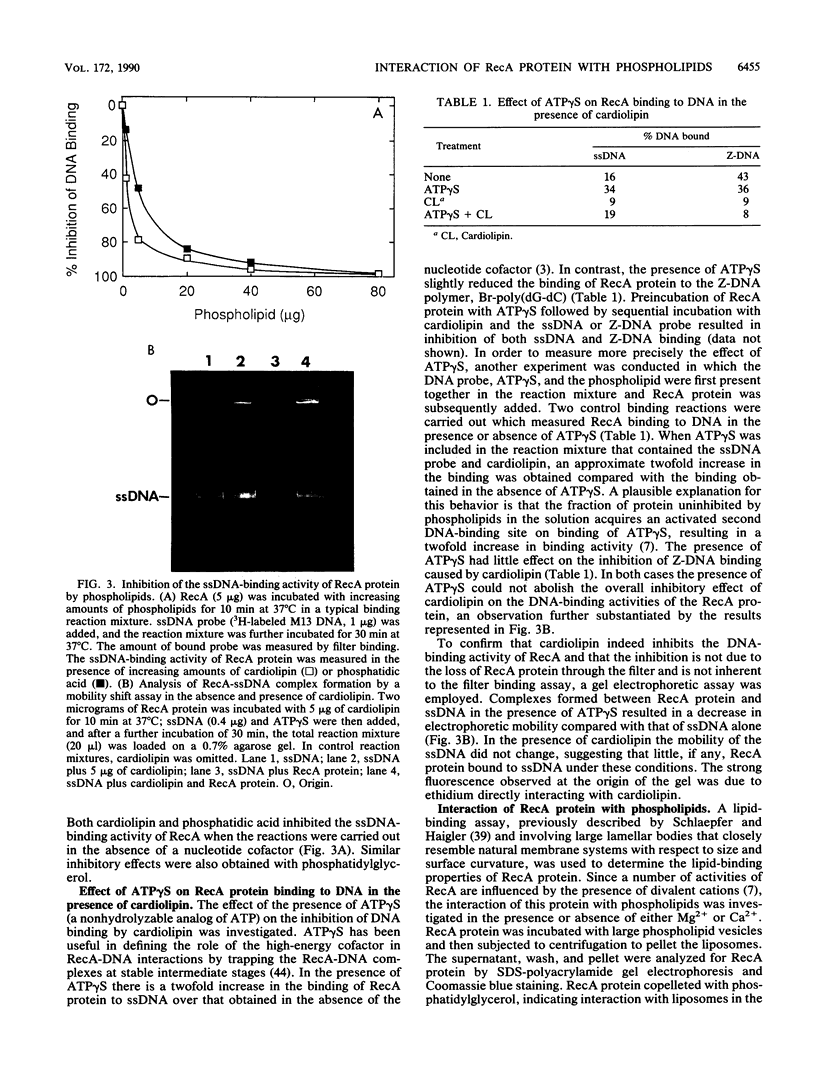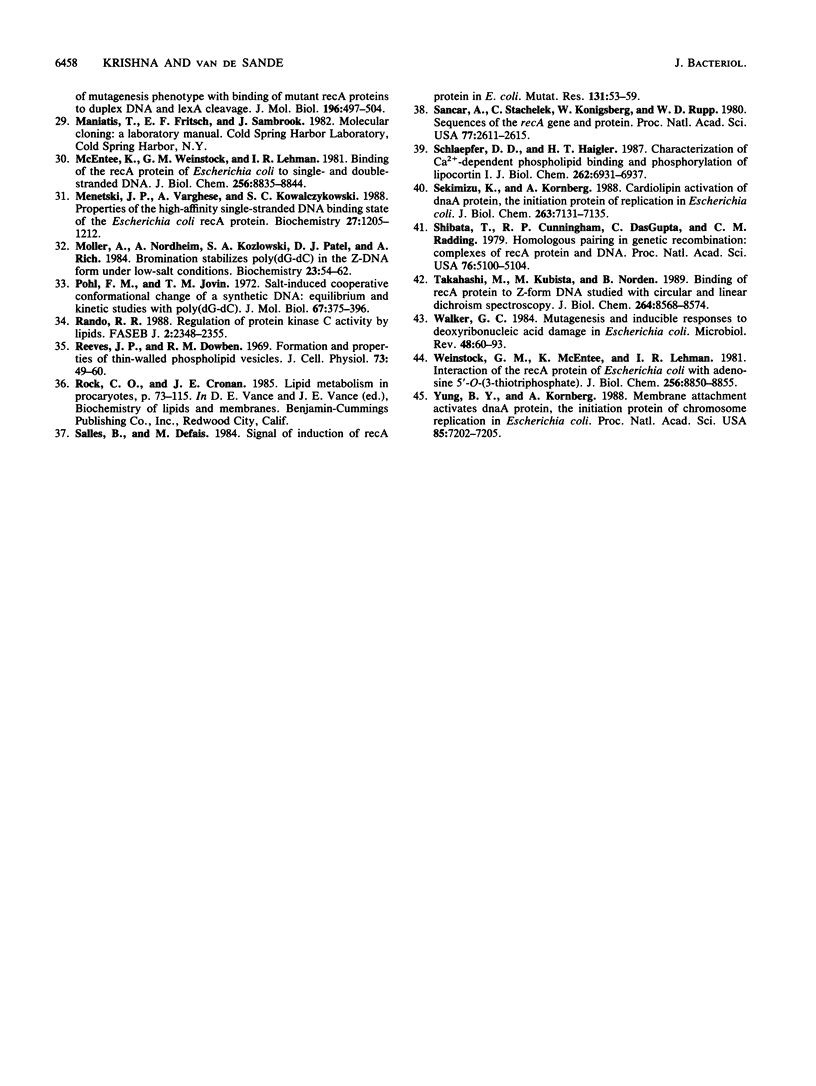Abstract
The RecA protein of Escherichia coli binds specifically to acidic phospholipids such as cardiolipin and phosphatidylglycerol. This binding appears to be affected by the presence of divalent cations such as Ca2+ and Mg2+. The interaction leads to the inhibition of RecA binding to at least two different conformations of DNA, single-stranded DNA and left-handed Z-DNA, thus suggesting that the phospholipids interact at the DNA-binding site of the RecA protein. Inclusion of a nucleotide cofactor [adenosine 5'-O-(gamma-thiotriphosphate)] in the reactions did not prevent the inhibition of DNA-binding activities of RecA protein by the phospholipids. The interaction of RecA protein with cardiolipin and phosphatidylglycerol, which represent two of the three major phospholipids of the E. coli membrane, may be physiologically important, as it provides a possible mechanism for the RecA-membrane association during the SOS response. These observations raise the possibility that the Z-DNA-binding activity of RecA protein is merely a manifestation of its phospholipid-binding property.
Full text
PDF






Images in this article
Selected References
These references are in PubMed. This may not be the complete list of references from this article.
- Benz R. Structure and function of porins from gram-negative bacteria. Annu Rev Microbiol. 1988;42:359–393. doi: 10.1146/annurev.mi.42.100188.002043. [DOI] [PubMed] [Google Scholar]
- Blaho J. A., Wells R. D. Left-handed Z-DNA binding by the recA protein of Escherichia coli. J Biol Chem. 1987 May 5;262(13):6082–6088. [PubMed] [Google Scholar]
- Bryant F. R., Taylor A. R., Lehman I. R. Interaction of the recA protein of Escherichia coli with single-stranded DNA. J Biol Chem. 1985 Jan 25;260(2):1196–1202. [PubMed] [Google Scholar]
- Cassuto E., Howard-Flanders P. The binding of RecA protein to duplex DNA molecules is directional and is promoted by a single stranded region. Nucleic Acids Res. 1986 Feb 11;14(3):1149–1157. doi: 10.1093/nar/14.3.1149. [DOI] [PMC free article] [PubMed] [Google Scholar]
- Cox M. M., Lehman I. R. Enzymes of general recombination. Annu Rev Biochem. 1987;56:229–262. doi: 10.1146/annurev.bi.56.070187.001305. [DOI] [PubMed] [Google Scholar]
- Cox M. M., McEntee K., Lehman I. R. A simple and rapid procedure for the large scale purification of the recA protein of Escherichia coli. J Biol Chem. 1981 May 10;256(9):4676–4678. [PubMed] [Google Scholar]
- Craig N. L., Roberts J. W. Function of nucleoside triphosphate and polynucleotide in Escherichia coli recA protein-directed cleavage of phage lambda repressor. J Biol Chem. 1981 Aug 10;256(15):8039–8044. [PubMed] [Google Scholar]
- Cunningham R. P., Shibata T., DasGupta C., Radding C. M. Single strands induce recA protein to unwind duplex DNA for homologous pairing. Nature. 1979 Sep 20;281(5728):191–195. doi: 10.1038/281191a0. [DOI] [PubMed] [Google Scholar]
- Dente L., Cesareni G., Cortese R. pEMBL: a new family of single stranded plasmids. Nucleic Acids Res. 1983 Mar 25;11(6):1645–1655. doi: 10.1093/nar/11.6.1645. [DOI] [PMC free article] [PubMed] [Google Scholar]
- Dressler D., Potter H. Molecular mechanisms in genetic recombination. Annu Rev Biochem. 1982;51:727–761. doi: 10.1146/annurev.bi.51.070182.003455. [DOI] [PubMed] [Google Scholar]
- Garvey N., St John A. C., Witkin E. M. Evidence for RecA protein association with the cell membrane and for changes in the levels of major outer membrane proteins in SOS-induced Escherichia coli cells. J Bacteriol. 1985 Sep;163(3):870–876. doi: 10.1128/jb.163.3.870-876.1985. [DOI] [PMC free article] [PubMed] [Google Scholar]
- Glenney J. Phospholipid-dependent Ca2+ binding by the 36-kDa tyrosine kinase substrate (calpactin) and its 33-kDa core. J Biol Chem. 1986 Jun 5;261(16):7247–7252. [PubMed] [Google Scholar]
- Gudas L. J., Pardee A. B. DNA synthesis inhibition and the induction of protein X in Escherichia coli. J Mol Biol. 1976 Mar 15;101(4):459–477. doi: 10.1016/0022-2836(76)90240-0. [DOI] [PubMed] [Google Scholar]
- Gudas L. J. The induction of protein X in DNA repair and cell division mutants of Escherichia coli. J Mol Biol. 1976 Jul 5;104(3):567–587. doi: 10.1016/0022-2836(76)90121-2. [DOI] [PubMed] [Google Scholar]
- Inouye M., Pardee A. B. Changes of membrane proteins and their relation to deoxyribonucleic acid synthesis and cell division of Escherichia coli. J Biol Chem. 1970 Nov 10;245(21):5813–5819. [PubMed] [Google Scholar]
- Irbe R. M., Morin L. M., Oishi M. Prophage (phi 80) induction in Escherichia coli K-12 by specific deoxyoligonucleotides. Proc Natl Acad Sci U S A. 1981 Jan;78(1):138–142. doi: 10.1073/pnas.78.1.138. [DOI] [PMC free article] [PubMed] [Google Scholar]
- Khamis M. I., Casas-Finet J. R., Maki A. H. Binding of recA protein to single- and double-stranded polynucleotides occurs without involvement of its aromatic residues in stacking interactions with nucleotide bases. Biochim Biophys Acta. 1988 Jul 13;950(2):132–137. doi: 10.1016/0167-4781(88)90005-x. [DOI] [PubMed] [Google Scholar]
- Kim J. I., Heuser J., Cox M. M. Enhanced recA protein binding to Z DNA represents a kinetic perturbation of a general duplex DNA binding pathway. J Biol Chem. 1989 Dec 25;264(36):21848–21856. [PubMed] [Google Scholar]
- Krishna P., Kennedy B. P., Waisman D. M., van de Sande J. H., McGhee J. D. Are many Z-DNA binding proteins actually phospholipid-binding proteins? Proc Natl Acad Sci U S A. 1990 Feb;87(4):1292–1295. doi: 10.1073/pnas.87.4.1292. [DOI] [PMC free article] [PubMed] [Google Scholar]
- Krishna P., Kennedy B. P., van de Sande J. H., McGhee J. D. Yolk proteins from nematodes, chickens, and frogs bind strongly and preferentially to left-handed Z-DNA. J Biol Chem. 1988 Dec 15;263(35):19066–19070. [PubMed] [Google Scholar]
- Laemmli U. K. Cleavage of structural proteins during the assembly of the head of bacteriophage T4. Nature. 1970 Aug 15;227(5259):680–685. doi: 10.1038/227680a0. [DOI] [PubMed] [Google Scholar]
- Lasic D. D. The mechanism of vesicle formation. Biochem J. 1988 Nov 15;256(1):1–11. doi: 10.1042/bj2560001. [DOI] [PMC free article] [PubMed] [Google Scholar]
- Leahy M. C., Radding C. M. Topography of the interaction of recA protein with single-stranded deoxyoligonucleotides. J Biol Chem. 1986 May 25;261(15):6954–6960. [PubMed] [Google Scholar]
- Little J. W., Mount D. W. The SOS regulatory system of Escherichia coli. Cell. 1982 May;29(1):11–22. doi: 10.1016/0092-8674(82)90085-x. [DOI] [PubMed] [Google Scholar]
- McEntee K., Weinstock G. M., Lehman I. R. Binding of the recA protein of Escherichia coli to single- and double-stranded DNA. J Biol Chem. 1981 Aug 25;256(16):8835–8844. [PubMed] [Google Scholar]
- Menetski J. P., Varghese A., Kowalczykowski S. C. Properties of the high-affinity single-stranded DNA binding state of the Escherichia coli recA protein. Biochemistry. 1988 Feb 23;27(4):1205–1212. doi: 10.1021/bi00404a021. [DOI] [PubMed] [Google Scholar]
- Möller A., Nordheim A., Kozlowski S. A., Patel D. J., Rich A. Bromination stabilizes poly(dG-dC) in the Z-DNA form under low-salt conditions. Biochemistry. 1984 Jan 3;23(1):54–62. doi: 10.1021/bi00296a009. [DOI] [PubMed] [Google Scholar]
- Pohl F. M., Jovin T. M. Salt-induced co-operative conformational change of a synthetic DNA: equilibrium and kinetic studies with poly (dG-dC). J Mol Biol. 1972 Jun 28;67(3):375–396. doi: 10.1016/0022-2836(72)90457-3. [DOI] [PubMed] [Google Scholar]
- Rando R. R. Regulation of protein kinase C activity by lipids. FASEB J. 1988 May;2(8):2348–2355. doi: 10.1096/fasebj.2.8.3282960. [DOI] [PubMed] [Google Scholar]
- Reeves J. P., Dowben R. M. Formation and properties of thin-walled phospholipid vesicles. J Cell Physiol. 1969 Feb;73(1):49–60. doi: 10.1002/jcp.1040730108. [DOI] [PubMed] [Google Scholar]
- Salles B., Defais M. Signal of induction of recA protein in E. coli. Mutat Res. 1984 Feb;131(2):53–59. doi: 10.1016/0167-8817(84)90011-7. [DOI] [PubMed] [Google Scholar]
- Sancar A., Stachelek C., Konigsberg W., Rupp W. D. Sequences of the recA gene and protein. Proc Natl Acad Sci U S A. 1980 May;77(5):2611–2615. doi: 10.1073/pnas.77.5.2611. [DOI] [PMC free article] [PubMed] [Google Scholar]
- Schlaepfer D. D., Haigler H. T. Characterization of Ca2+-dependent phospholipid binding and phosphorylation of lipocortin I. J Biol Chem. 1987 May 15;262(14):6931–6937. [PubMed] [Google Scholar]
- Sekimizu K., Kornberg A. Cardiolipin activation of dnaA protein, the initiation protein of replication in Escherichia coli. J Biol Chem. 1988 May 25;263(15):7131–7135. [PubMed] [Google Scholar]
- Shibata T., Cunningham R. P., DasGupta C., Radding C. M. Homologous pairing in genetic recombination: complexes of recA protein and DNA. Proc Natl Acad Sci U S A. 1979 Oct;76(10):5100–5104. doi: 10.1073/pnas.76.10.5100. [DOI] [PMC free article] [PubMed] [Google Scholar]
- Takahashi M., Kubista M., Nordén B. Binding of recA protein to Z-form DNA studied with circular and linear dichroism spectroscopy. J Biol Chem. 1989 May 25;264(15):8568–8574. [PubMed] [Google Scholar]
- Walker G. C. Mutagenesis and inducible responses to deoxyribonucleic acid damage in Escherichia coli. Microbiol Rev. 1984 Mar;48(1):60–93. doi: 10.1128/mr.48.1.60-93.1984. [DOI] [PMC free article] [PubMed] [Google Scholar]
- Weinstock G. M., McEntee K., Lehman I. R. Interaction of the recA protein of Escherichia coli with adenosine 5'-O-(3-thiotriphosphate). J Biol Chem. 1981 Aug 25;256(16):8850–8855. [PubMed] [Google Scholar]
- Yung B. Y., Kornberg A. Membrane attachment activates dnaA protein, the initiation protein of chromosome replication in Escherichia coli. Proc Natl Acad Sci U S A. 1988 Oct;85(19):7202–7205. doi: 10.1073/pnas.85.19.7202. [DOI] [PMC free article] [PubMed] [Google Scholar]




